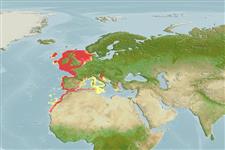sub class Elasmobranchii (ฉลามและกระเบน) (sharks and rays) >
Rajiformes (Skates and rays) >
Rajidae (Skates)
Etymology: Raja: Latin, raja, -ae = a sting ray (Raja sp.) (Ref. 45335).
Environment: milieu / climate zone / depth range / distribution range
นิเวศวิทยา
เกี่ยวกับทะเล,น้ำเค็ม สัตว์น้ำหน้าดิน; ระดับความลึก 10 - 380 m (Ref. 6808). Temperate; 60°N - 22°N, 18°W - 24°E
Eastern Atlantic: Shetland Islands to Morocco, Rio de Oro (Western Sahara), and Madeira.
Length at first maturity / ขนาด / น้ำหนัก / Age
Maturity: Lm 90.2, range 60 - ? cm
Max length : 120 cm TL เพศผู้/กระเทย; (Ref. 41333); 125.0 cm TL (female); น้ำหนักสูงสุดที่มีการรายงาน: 14.3 kg (Ref. 40637)
เงี่ยงครีบหลัง (รวม) : 0; เงี่ยงครีบก้น: 0. Upper surface wholly prickly, except in juveniles; underside only prickly along front margins of disc; orbital thorns separate; a regular median row of 40-45 thorns in juveniles and adult females, interrupted on back in males; 60-90 tooth rows; upper surface ochre, with numerous small dark spots to margins of disc, underside white (Ref. 3167).
Found on sand and sand-rock bottoms (Ref. 6808). Feed on all kinds of benthic animals (Ref. 3167). Oviparous. Distinct pairing with embrace. Young may tend to follow large objects, such as their mother (Ref. 205). Eggs are oblong capsules with stiff pointed horns at the corners deposited in sandy or muddy flats (Ref. 205). Egg capsules are 10.0-14.3 cm long and 5.8-9.0 cm wide (Ref. 41250). About 40-90 eggs are laid per individual every year (Ref. 41250).
Oviparous, paired eggs are laid. Embryos feed solely on yolk (Ref. 50449). Spawning mainly from February to August with at least 30 egg-cases laid (Ref. 3167). Distinct pairing with embrace. Young may tend to follow large objects, such as their mother (Ref. 205).
McEachran, J.D. and K.A. Dunn, 1998. Phylogenetic analysis of skates, a morphologically conservative clade of elasmobranchs (Chondrichthyes: Rajidae). Copeia 1998(2):271-290. (Ref. 27314)
IUCN Red List Status (Ref. 130435)
Threat to humans
Harmless
Human uses
การประมง: มีการค้าเพียงเล็กน้อย; การตกปลาเป็นกีฬา: ใช่
เครื่องมือ
Special reports
Download XML
แหล่งที่มาจากอินเตอร์เน็ต
Estimates based on models
Preferred temperature (Ref.
123201): 7.1 - 16.2, mean 10.3 °C (based on 462 cells).
Phylogenetic diversity index (Ref.
82804): PD
50 = 0.5000 [Uniqueness, from 0.5 = low to 2.0 = high].
Bayesian length-weight: a=0.00224 (0.00144 - 0.00349), b=3.27 (3.15 - 3.39), in cm total length, based on LWR estimates for this species & Genus-body shape (Ref.
93245).
ระดับชั้นอาหาร (Ref.
69278): 3.8 ±0.61 se; based on food items.
ความสามารถในการกลับคืนสู่ปกติ (Ref.
120179): ต่ำ, เวลาต่ำสุดที่จะทำให้ประชากรเพิ่มขึ้นเป็น 2 เท่าใช้เวลา 4.5 - 14 ปี (K=0.12-0.19; tmax=15; Fec=40).
Prior r = 0.20, 95% CL = 0.13 - 0.30, Based on 1 full stock assessment.
Fishing Vulnerability (Ref.
59153): High to very high vulnerability (65 of 100).
Climate Vulnerability (Ref.
125649): High vulnerability (61 of 100).
Nutrients (Ref.
124155): Calcium = 4.69 [0.73, 84.95] mg/100g; Iron = 0.26 [0.02, 2.99] mg/100g; Protein = 16.7 [13.9, 19.0] %; Omega3 = 0.869 [0.349, 2.113] g/100g; Selenium = 14.8 [3.0, 71.4] μg/100g; VitaminA = 7.7 [0.6, 90.3] μg/100g; Zinc = 0.31 [0.02, 3.43] mg/100g (wet weight);
